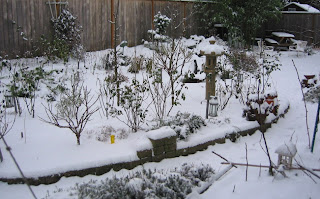 Unlabeled photo, no names. This has nothing to do with garden, bike, environment, or anything else in this blog, but I liked the photo. My guess, early 20th Century, Pacific Northwest (bought here in Vancouver WA). Who are these people?
Unlabeled photo, no names. This has nothing to do with garden, bike, environment, or anything else in this blog, but I liked the photo. My guess, early 20th Century, Pacific Northwest (bought here in Vancouver WA). Who are these people?
Saturday, January 20, 2007
Estate Sale Photo
 Unlabeled photo, no names. This has nothing to do with garden, bike, environment, or anything else in this blog, but I liked the photo. My guess, early 20th Century, Pacific Northwest (bought here in Vancouver WA). Who are these people?
Unlabeled photo, no names. This has nothing to do with garden, bike, environment, or anything else in this blog, but I liked the photo. My guess, early 20th Century, Pacific Northwest (bought here in Vancouver WA). Who are these people?
Tuesday, January 16, 2007
It snowed. Off work today afternoon.
Tomato seeds came in the mail.
Saturday, January 13, 2007
Mid Winter. Planning Tomato Garden.

There are several reasons that I keep this blog. One is that it helps me look back to previous years & see what was happening then, and what worked then. That way, I have an idea of when to plant, or prune, or do other tasks this year. In the dead of Winter, it helps to look back on previous seasons and remember that there really is an end to the gloom. It also helps as a repository of notes that I might want to refer to later (hence the labels and links).
This posting serves multiple roles. The bowl of tomatoes from August reminds me that there was 'edible sunshine' only a few months ago, and suggests that the same is possible a few months from now. It also reminds me that my impression of what worked is reasonable. The information that follows tells me somthing about the choices that I am making this year.
One of the challenges when I started trying to grow tomatoes here was disease. The plants became large and green, then whole vines blackened and died. I think that the main problems were susceptibility to disease, and method of growth that encouraged disease.
There are many tomato diseases - looking at a list is daunting. Makes me wonder how anyone can grow them - but most people do, in most parts of the country, without any problems.
Since most diseases seem to bounce up from the soil to the plant, and grow best on wet leaves, one preventive method is to change how I grew the plants. During the first attempts, I used tomato cages. Now, I grow the vines as cordons, up a single post, so that the leaves and fruit are high off above the ground. Suckers are pinched off in order to maintain the single stem structure. The soil has been mulched with fresh fir bark. I didn't add any nitrogen fertilizer (on the theory that high nitrogen promotes rank but disease susceptable growth) but rather added supplement to the soil during the Winter, which had been turned into the soil in Spring. Those supplements were mainly coffee grounds (in large amounts), leaves, last year's bark mulch, and a scattering of egg shells for calcium. Many of these ideas are presented by others for disease prevention. I've used this method for 2 years with very good results, so suspect that I'm on the right track. The plan for 2007 will be the same.
Clemson University also suggests a rotation system wtih marigolds, to prevent nematodes. I may try that too, depending on my ambition this summer. Marigolds are popular as nematode treatment, although some work better than others.
In addition, I'm paying attention to disease susceptibility (or the other side of the same coin, resistance). The main listed diseases (in resistance profiles) are:
Fusarium Wilt. I suspect that I have seen this on the tomatoes, although if present in the past 2 years, it was very limited. In previous years I think this is what caused loss of most of the crop.
Verticillium Wilt. I suspect that I have also seen this.
Alternaria Stem Canker. I dont think that I have seem this.
Nematode. I have read that fig nematodes dont do well in a clay soil, such as present here - although I 've been improving the soil, and I don't know if the same rules apply to tomato nematodes. I have not seen root knots like these so I don't think that this is an issue at this time.
In addition to culture methods, diseases are prevented (or their impact reduced) by planting disease resistant varieties. Of the choices that I made so far this year -
Better Boy VFNASt
Celebrity Hybrid VFFNTASt
Super Sweet 100 VF
Lemon Boy VFN
Where V=verticillium resistance, F=fusarium wilt resistance (more Fs meaning more strains of fusarium), T=tobacco mosaic virus, A=alternaria stem cancer, N=nematode.
In the Cornell table, the SS100 is also TMV resistant., and Lemon Boy is resistant to Alternaria, fusarium I, gray leaf spot, nematode, verticillium I. Organic gardening seems to think that Brandywine is 'disease resistant' but isn't more specific. Wikipedia states that heirlooms' disease resistance is "dubious at best'. I didnt see much problem with Brandywines during the past two years, and Cherokee Purple also lived until the frost, so my experience, while very limited, is so far OK.
Of course, resistance to a specific disease is only an issue if that disease is a risk, but I think that the broader spectrum of resistance the better.
Subscribe to:
Comments (Atom)




